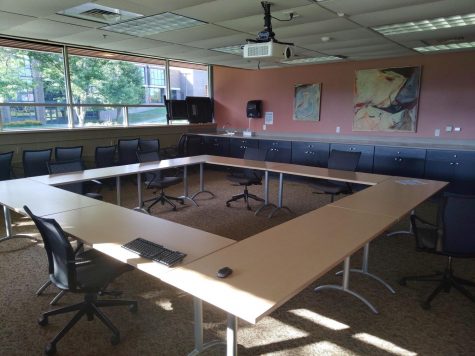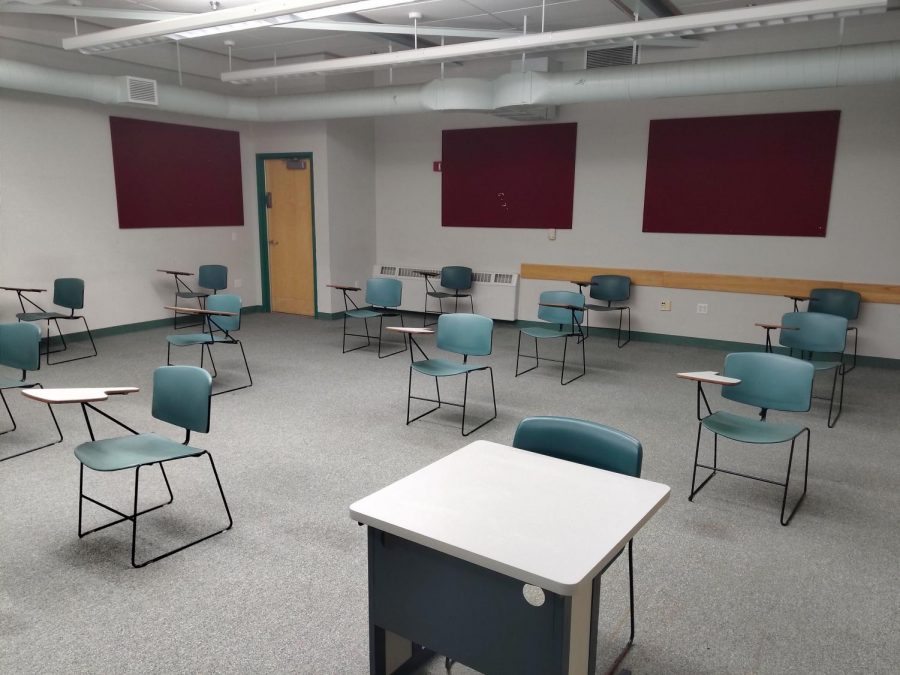It’s not all doom and gloom on Zoom
To accommodate social distancing, the capacity of a classroom must be physically managed.
The fall 2020 semester at NVU-J looks a lot different than any of its predecessors. There’s significantly less traffic on the quad and everyone within sight is masked and spaced apart in compliance with state-mandated health practices. It’s an otherworldly sight for those who have been here before and an unfortunate norm for those who have only recently joined campus life.
Considering the COVID-19 pandemic, course delivery has adjusted to these new norms, though the breakdown of class types is still weighted towards in-person delivery. Provost Nolan Atkins noted in a recent Basement Medicine interview that approximately 62 percent of the 600 sections across both campuses have some form of face-to-face component, whether it was an in-person class or a hybrid format that only met once a week.
When it comes to the remote and online course delivery formats, the numbers are significantly lower, with only six percent of sections fully online. Remote learning takes up the rest of the pie and in all, students at NVU this fall can likely expect to have at least some in-class interaction, though social distancing and mask guidelines will still apply, at least for now.
Students on campus appear optimistic, given the new norms of course delivery. “It’s okay. I definitely, I’ve gotten a lot about like, whether or not our course load is different, and I don’t really feel like it is,” said Serina Pesinkowski, a first semester senior. “But almost all of my classes are online, even art classes.”
Others have found that there’s something different about taking classes remotely, “It’s definitely a learning curve with professors but it’s going well. It’s easy to talk to people on Zoom, but also the new way of learning,” Kayla Irick said of her experience.
Shaylin Clifford agreed, when asked about her thoughts on Zoom lectures. “It’s okay, but it’s easier to raise your hand in person and there is less of a bond than an in-person class.”
Granted, there have been adjustments and tweaks here and there to accommodate the new reality that is a socially distanced world. For example, more lab sections are available for classes that require them, allowing students to spread out so that the new occupancy requirements can be met. In Dibden, where a large portion of the space is unavailable for gatherings and events, some theatre courses are still taking place, mostly in the main hall where there is room to hold small groups of students on the stage. In other cases, remote learning is being used when students want or need to remain in their rooms for classes.

Asked about whether or not her classes were accessible, Pesinkowski had this to say, “For me, yeah. My computer’s not the greatest, but it works well enough,” she said. “Sometimes it lags. It’s less that it’s hard to hear them and more that it’s delayed, and then I’m like, ‘Oh, well if there’s a question, I missed the opportunity to answer,’ but thankfully that usually isn’t too big of an issue. I live in Governor’s, so, it’s a good spot for Wi-Fi.”
On the other side of the classroom, professors have also seen changes when it comes to classes this semester. One program, however, is doing quite well in respect to these new mandates and accommodations, namely the Outdoor Education, Leadership, and Tourism program at NVU-Johnson.
Environmental and Health Sciences co-chair Brad Moskowitz noted a promising outlook for the courses under the Environmental and Health Sciences umbrella.
“Many of the field classes are being held as planned, with modifications,” said Moskowitz. “The great thing about outdoor education is that we are mostly outside, where we can comfortably distance and even take masks off when appropriate. Learning more about the natural environment, how to comfortably enjoy the outdoors and how to effectively lead and teach others are critically important skills during this pandemic.”
Moskowitz notes, however, that even the benefits of being an outdoor-focused program still aren’t enough to allay all of the concerns about the pandemic. “We have one of the smallest incoming classes that I have seen in 20 years and a few of our students chose to not return to NVU this fall. I am sure that some of this has to do with the pandemic and concerns about what we can’t do, and the uncertainty surrounding all things COVID,” he said. “Yet, I wish people would focus on what we can do, even during these difficult times.”
For other departments, the results are mixed. The education major in particular has seen significant changes in how they conduct their classes. “For our classes, we’ve had to make a lot of changes in the way we teach,” said Hannah Miller, chair of the Education department, “However, the biggest impact in the Education department in terms of delivery of courses is for our practicum and student teachers. Not only are they having to juggle hybrid and remote college courses, they are also having to navigate K-12 schools, which are also teaching using a combination of in-person and remote delivery.”
In the end, classes are continuing, no matter how they are delivered. As for the students and faculty, they’re just taking each day as it comes, and working to make this semester the best experience it can be under challenging circumstances.

Senior, BFA Creative Writing major from Craftsbury, VT.
Resident Punk Scientist and Basement Medicine Web Wrangler.
I love science and writing, and...



